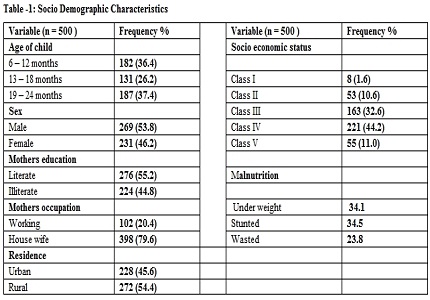Knowledge of complementary feed and its effect on the child nutrition
Abstract
Introduction: Introduction of semisolid food in an infant who is on liquid diet is known as complementary feeding. When breast milk is no longer enough to meet the nutritional needs of the infant, complementary feeding should be started.
Methods: 500 mothers with children 6-24 months of age attending OPD in Mc Gann were interviewed. Data was collected using a self-administered, semi-structured questionnaire with the mothers regarding knowledge, attitude, and practices of complementary feeding
Results: Knowledge, attitude and practices were assessed in 500 mothers. The mean age of complementary feeding was 8.24 ± 2.79 months. Only few had correct information from health personnel. 23% of mothers started complementary feeding at 6 months of age. 21.6% of mothers used commercial foods. Male child, illiterate mothers, low socio-economic group and rural mothers tend to wean late (p<0.001). Parity, had no influence on complementary feeding age (p>0.05). 34.1%, 34.5% and 23.8% of children were under weight, stunted and wasted respectively. There was significant association between delayed complementary feeding and malnutrition of the child.
Conclusion: There is lack of knowledge in mothers regarding complementary feeding, there has to be proper recommendation about timing of complementary feeding. Mean age of complementary feeding was delayed due to improper information, false beliefs and attitudes, illiteracy, low socio-economic status and rural mothers, thus leading to malnutrition of the child. Hence, mothers should be educated properly regarding complementary feeding, foods, preparation and practice to prevent malnutrition and improve the health status of the children.
Downloads
References
2. Ruth. A Lawrence and Robert. M Lawrence. Breast feeding a guide for the medical profession; Elsevier publications, 6 th edn, 2005; 357-375.
3. Vossenaar M, Doak CM, Solomons NW. Challenges in the elaboration of a field interview instrument to capture information for the evaluation of adherence to the WHO/PAHO Guiding Principles for Complementary Feeding of the Breastfed Child. Food Nutr Bull. 2014 Sep;35(3):338-50. [PubMed]
4. WHO. Global Strategy for Infant and Young Child Feeding. Geneva: World Health Organization. WHA55/2002/REC/1 Annex 2, 2002.
5. WHO Anthro for personal computers, version 2, 2007: Software for assessing growth and development of the world's children. Geneva: WHO, 2007. http://www.who.int/childgrowth/software. [PubMed]
6. Aggarwal A, Verma S, Faridi M; Dayachand. Complementary feeding--reasons for inappropriateness in timing, quantity and consistency. Indian J Pediatr. 2008 Jan;75(1):49-53. [PubMed]
7. Frazier JP, Countie D, Elerian L. Parental barriers to weaning infants from the bottle. Arch Pediatr Adolesc Med. 1998 Sep;152(9):889-92. [PubMed]
8. Banapurmath CR, Nagaraj MC, Banapurmath S, Kesaree N. Breastfeeding practices in villages of central Karnataka. Indian Pediatr. 1996 Jun;33(6):477-9. [PubMed]
9. Pant I, Chothia K. Maternal knowledge regarding breast feeding and weaning practices. Indian J Pediatr. 1990 May-Jun;57(3):395-400. [PubMed]
10. Chaturvedi M, Nandan D, Gupta SC. Rapid assessment of infant-feeding practices in Agra district. Indian J Community Med 2007; 32:227.
11. Ganjoo C, Rowlands R. Breast feeding and weaning practices of urban housewives in Srinagar. Indian J Nutr Diet. 1988 Nov;25(11):354-8. [PubMed]
12. Singh MB, Haldiya KR, Lakshminarayana J. Infant feeding and weaning practices in some semi-arid rural areas of Rajasthan. J Indian Med Assoc. 1997 Nov;95(11):576-8, 590. [PubMed]
13. Khan ME. Breast-feeding and weaning practices in India. Asia Pac Popul J. 1990 Mar;5(1):71-88. [PubMed]
14. NFHS-3.National Family Health Surveys, National fact sheet – India and Karnataka. 2007. www.nfhsindia.org.
15. Khokhar A, Singh S, Talwar R, Rasania SK, Badhan SR, Mehra M. A study of malnutrition among children aged 6 months to 2 years from a resettlement colony of Delhi. Indian J Med Sci. 2003 Jul;57(7):286-9. [PubMed]
16. Medhi GK, Mahanta J. Breastfeeding, weaning practices and nutritional status of infants of tea garden workers of Assam. Indian Pediatr. 2004 Dec;41(12):1277-9. [PubMed]
17. Sabu s padmadas, Inge hutter and Frans willekens. Complementary feeding initiation patterns and subsequent linear growth progression among children aged 2 – 4 years in India. International journal of epidemiology 2002; 31:855-863

Copyright (c) 2016 Author (s). Published by Siddharth Health Research and Social Welfare Society

This work is licensed under a Creative Commons Attribution 4.0 International License.


 OAI - Open Archives Initiative
OAI - Open Archives Initiative


